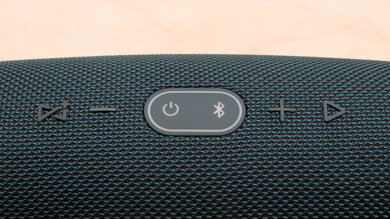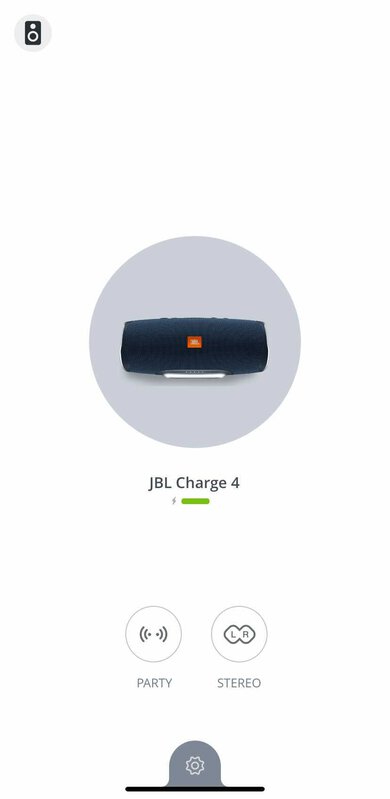The JBL Charge 4 is a portable Bluetooth speaker that comes in many colors. It has a balanced mid-range that can accurately reproduce vocals and lead instruments, though they may sound slightly dull due to its underemphasized treble range. It's also rated IPX7 for water resistance, meaning it's certified to be immersible in up to a meter of water for 30 minutes. Like many smaller speakers, it struggles to produce low-bass, which might disappoint fans of bass-heavy genres like EDM and hip-hop. Also, unlike the JBL Charge 5, it doesn't have an EQ, so you can't tweak its sound profile to your liking.
Our Verdict
The JBL Charge 4 is sub-par for music. It struggles to produce low-bass, and its treble range is underemphasized, so higher frequencies can sound dull and veiled. Fortunately, its mid-range is well-balanced, so vocals and lead instruments are reproduced accurately. This speaker doesn't have an EQ, so you can't adjust the sound to your liking.
- Lightweight and portable.
- Great battery performance.
- Well-balanced mid-range.
- Struggles to produce low-bass.
- Doesn't have an EQ.
- Requires second unit for stereo sound.
- Underemphasized treble range.
- Disappointing soundstage.
The JBL Charge 4 is sub-par for videos and music. While its well-balanced mid-range can accurately reproduce dialogue, the speaker struggles to produce low-bass, meaning you won't feel the deep thump and rumble in action-packed movie scenes. It also has a fairly directional soundstage, resulting in a less immersive sound. Thankfully, its low latency with iOS and Android devices makes it suitable for watching videos, although some apps may compensate differently for this.
- Well-balanced mid-range.
- Struggles to produce low-bass.
- Doesn't have an EQ.
- Underemphasized treble range.
The JBL Charge 4 is alright for podcasts. It has a well-balanced mid-range, so dialogue is reproduced accurately. However, its treble range is underemphasized, so sibilants like S and T sounds can be perceived as dull. This speaker is remarkably portable, so you can listen to podcasts while you're on the go.
- Lightweight and portable.
- Well-balanced mid-range.
- Underemphasized treble range.
- Disappointing soundstage.
The JBL Charge 4 doesn't have voice assistant support.
The JBL Charge 4 is reasonable for outdoor use. It has an IPX7 rating for water resistance that certifies it to be immersible in up to a meter of water for 30 minutes, so you don't have to worry about it getting wet when taking it outdoors with you. Thanks to its fairly small and lightweight build, it's incredibly portable, so you can easily bring it with you out and about. However, it doesn't get especially loud, and there's some compression at max volume.
- Lightweight and portable.
- IPX7 rating for water resistance.
- Great battery performance.
- Struggles to produce low-bass.
- Doesn't have an EQ.
- Disappointing soundstage.
Changelog
- Updated Oct 03, 2024: This review has been updated to mention the Ultimate Ears EVERBOOM in the Soundstagesection.
- Updated Dec 20, 2022: Changed Track Next/Previous from No to Forward Only (Physical).
- Updated Jan 31, 2022: Updated review for accuracy and clarity.
- Updated Feb 16, 2021: Review published.
Check Price
Differences Between Sizes And Variants
The JBL Charge 4 comes in twelve different color variants. These include 'Black', 'Black Camo', 'Blue', 'Camouflage', 'Grey', 'Green', 'Pink', 'Red', 'Sand', 'Teal', 'White', and 'Yellow'. We tested the 'Blue' variant, and you can see the label for the model we tested here. We expect all the variants listed to perform similarly in tests.
If you come across a variant not mentioned here, let us know in the discussions, and we'll update our review.
Popular Speaker Comparisons
The JBL Charge 4 is a fairly small, portable Bluetooth speaker. It has a sturdy build and an IPX7 rating for water resistance certifying it to be immersible in up to a meter of water for 30 minutes. Its mid-range is fairly well-balanced, so vocals and lead instruments are reproduced clearly, although they can seem a bit dull due to the underemphasized treble range. It also struggles to produce a thumpy low-bass, and unlike the JBL Charge 5, it doesn't have an EQ to help you adjust its sound to your liking. Also, while you can connect it to other Connect+ JBL speakers like the JBL Flip 4, it can't be connected to JBL's PartyBoost-compatible speakers like the JBL Charge 5 and the JBL Boombox 2.
See also our recommendations for the best Bluetooth speakers, the best shower speakers, and the best waterproof Bluetooth speakers.
The JBL Charge 5 is a better speaker than the JBL Charge 4. The Charge 5 has a more balanced sound profile. It's also better built and has an IP67 rating for dust and water resistance, certifying it to be dust-tight and immersible in a meter of water for 30 minutes. That said, while the Charge 5 can connect to PartyBoost-compatible JBL speakers, it can't connect to those with the Connect+ feature like its predecessor. The Charge 4 has lower latency with iOS and Android devices, though some apps compensate for latency differently, so your experience may vary.
The JBL Flip 6 is a better speaker than the JBL Charge 4 overall. The Flip 6 is smaller and has a removable carrying strap to help transport it, making it more portable. It's better built and has a better-balanced sound profile out-of-the-box. You can even customize its sound to your liking, thanks to the graphic EQ featured in its companion app. The Charge 4 can produce a slightly more extended low-bass than the Flip 6. It has less compression present at max volume, resulting in cleaner audio at louder volumes. It has a longer-lasting battery life of over 13 hours from a single charge, though this varies depending on your usage.
The JBL Flip 5 is a better speaker than the JBL Charge 4. The FLIP has better directivity, resulting in a wider soundstage. It also has a more balanced sound profile. However, the Charge has a longer battery life.
The JBL Flip 4 is a better speaker than the JBL Charge 4. The Flip 4 has a better-balanced sound profile out-of-the-box and can play stereo content without downmixing it to mono, which is more immersive. It supports voice assistants through your smartphone and is smaller, making it more portable. However, the Charge 4 can produce a more extended low-bass than the Flip 4. It also has a longer-lasting battery life, though this can vary depending on your usage, and your experience may differ.
Test Results

The JBL Charge 4 is a fairly small cylindrical speaker that sits horizontally on a plastic base, like the JBL Charge 5. It comes in twelve color variants, so you can find a look that suits your style. It has a bass radiator on each side, advertised to help produce a more resonant bass sound.
The JBL Charge 4 is outstandingly portable. This small battery-powered Bluetooth speaker is pretty lightweight and can be held in one hand, so you can easily bring it along with you when you're out and about.
The JBL Charge 4 has a good build quality. It has an IPX7 rating for water resistance that certifies it to be immersible in up to a meter of water for 30 minutes. Its materials feel pretty solid and sturdy. The body of the speaker is wrapped in a tight fabric and sits horizontally on a small plastic base. The back of the speaker also has a small sealable compartment for the USB and AUX ports.
The JBL Charge 4's buttons are clicky, and most are texturized, making them easy to press. You can press the play/pause button twice to skip a track, but you can't go to a previous track. In addition to buttons for adjusting the volume, there's a Bluetooth button and a Connect+ button, which lets you pair up to 100 JBL speakers that have the Connect+ feature. There's a light to indicate the Bluetooth pairing status and lights at the bottom that indicate the battery life. This speaker chimes when you've reached max volume, though there's no prompt for reaching the minimum volume.
The JBL Charge 4's frequency response accuracy is sub-par. It has a balanced mid-range that ensures vocals and lead instruments sound clear and present in the mix. That said, higher-pitched voices and instruments can sound a bit dull and veiled at times. Like most speakers its size, it lacks the deep thump and rumble in low-bass that's typically present in bass-heavy music like hip-hop. Unfortunately, unlike the JBL Charge 5, it doesn't come with a graphic EQ to customize its sound to your liking.
The JBL Charge 4's soundstage performance is disappointing. It needs to be paired to another unit to play stereo audio and downmixes stereo content to mono when using it on its own, which isn't as immersive. Its directivity is also just okay, so you'll perceive its soundstage as narrow and directional. The overemphasis in the treble range can also make the soundstage feel uneven. For a JBL speaker with a wider-sounding soundstage, you can check out the JBL Pulse 4 or the Ultimate Ears EVERBOOM.
The JBL Charge 4's dynamics are alright. It doesn't get very loud, and there's some compression present at max volume that can degrade audio quality as you increase the speaker's volume, so it isn't suitable for large crowded parties. If you're looking for a portable speaker that can get louder, consider the Anker Soundcore Motion Boom.
The JBL Charge 4 has an excellent battery performance. It's advertised to last around 20 hours off a single charge, but in our tests, it lasted just over thirteen hours. That said, battery life can vary depending on usage. Fortunately, it saves power by shutting off automatically after some time without any audio input.
The JBL Portable app is alright. It's compatible with iOS and Android, and you can use it to link two speakers to create a stereo pair. It also has a Party Mode feature, letting you connect multiple speakers to amplify the sound in a large space. However, unlike the Ultimate Ears BOOM 3, it lacks an EQ to help you customize the speaker's sound to your liking.
The JBL Charge 4 has an AUX port, meaning you can use a wired connection between your smartphone and the speaker. You can also use it to charge other devices using its USB-A port. Both ports are on the back of the speaker in a small, sealable compartment.
The JBL Charge 4 has an outstanding Bluetooth performance. You can pair two devices at a time, which is helpful if you frequently switch the audio source between your phone and your laptop. Its latency with iOS and Android devices is extremely low, making it suitable for watching videos. However, some apps compensate for latency differently, meaning individual experience may vary. It also has an exceptional range, so it can receive input even if your device is far away.






